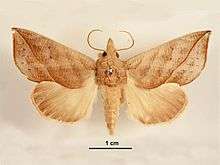Calyptra minuticornis
Calyptra minuticornis, the vampire moth, is a moth of the family Erebidae. It has been found in Indonesia, Java, India, Sri Lanka, and Australasia.[3]
| Vampire moth | |
|---|---|
 | |
| Dorsal view | |
.jpg) | |
| Scientific classification | |
| Kingdom: | Animalia |
| Phylum: | Arthropoda |
| Class: | Insecta |
| Order: | Lepidoptera |
| Superfamily: | Noctuoidea |
| Family: | Erebidae |
| Genus: | Calyptra |
| Species: | C. minuticornis |
| Binomial name | |
| Calyptra minuticornis | |
| Synonyms[2] | |
| |
Description
Its wingspan is about 50 mm. The antennae of the male are minutely ciliated. Forewings with rounded outer margin.[4] Head and thorax pale reddish brown and thickly irrorated with grey. Abdomen pale fuscous. Forewings with pale red-brown with a silvery sheen and numerous fine pale striae. There are traces of sub-basal, antemedial, and medial oblique line present. A rufous line runs from apex to inner margin beyond middle. A series of submarginal specks present. Hindwings pale fuscous and cilia whitish. Larva olive-grey with a sub-dorsal series of black-bordered yellow spots. A sub-lateral series of specks enclosed from fourth somite by a pinkish bordered black line. Head ochreous, with paired lateral black spots. Legs pale pink.[5]
The caterpillar feeds on Stephania japonica, Cissampelos, Cocculus and Cyclea species. It pupates in a cocoon between joined dead leaves in ground debris. The adult is a fruit piercer and also observed to pierce skins of buffalo, zebu, tapir and even humans in labs to suck blood.[6][7]
References
- Beccaloni, G.; Scoble, M.; Kitching, I.; Simonsen, T.; Robinson, G.; Pitkin, B.; Hine, A.; Lyal, C., eds. (2003). "Calyptra minuticornis". The Global Lepidoptera Names Index. Natural History Museum. Retrieved April 19, 2018.
- Savela, Markku Savela. "Calyptra minuticornis (Guenée, 1852)". Lepidoptera and Some Other Life Forms. Retrieved 13 January 2019.
- Zaspel, J.M.; Branham, M.A. (September 26, 2008). "World Checklist of Tribe Calpini (Lepidoptera: Noctuidae: Calpinae)" (PDF). Insecta Mundi: A Journal of World Insect Systematics. 0047 (1–15): 2. Retrieved 29 August 2010.
- "Calyptra minuticornis". Japanese Moths (in Japanese). Retrieved 30 August 2010.
- Hampson, G. F. (1894). The Fauna of British India, Including Ceylon and Burma: Moths Volume II. Taylor and Francis – via Biodiversity Heritage Library.
- Herbison-Evans, Don & Crossley, Stella (28 February 2015). "Calyptra minuticornis (Guenée, 1852) Vampire Moth". Australian Caterpillars and their Butterflies and Moths. Retrieved 13 January 2019.
- "Calyptra minuticornis Guenée". The Moths of Borneo. Retrieved 18 August 2016.